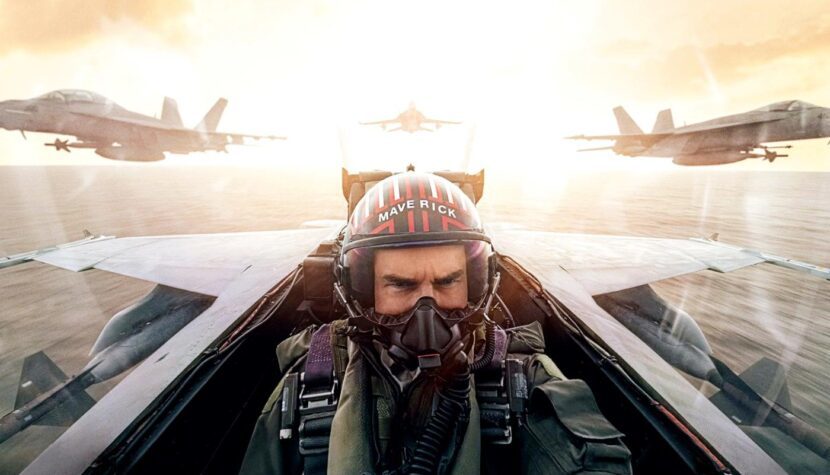TOP GUN: MAVERICK. Excellent blockbuster

Cinema is perverse. Yes, I know – it’s a truism. So I will try differently: being a spectator can be perverse. When it was announced that after more than 30 years there would be a sequel to Top Gun, I was among those who didn’t react positively. However, despite the belief that re-heating the classics of the 80s cinema is an idea that no one needs, I went to the screening of Top Gun: Maverick with great interest. There were several reasons for this: the impressive promotional campaign for the film, the powerful cinematic nostalgia accompanying this sequel, and above all, the desire to see if Tom Cruise still had that sparkle that I believed was the project’s only hope. I reassure the fans in advance: it definitely has.
Top Gun: Maverick is the responsibility of Joseph Kosinski, a creator on the one hand moderately experienced (this is only his fourth full-length feature), and on the other who has both collaborated with Tom Cruise on Oblivion and refreshed the classic 1980s film after a very long time (Tron: Legacy, 28 years since the premiere of the first part). This time the time gap turned out to be even bigger – Top Gun and its sequel are separated by as many as 36 years – but Kosinski perfectly coped with the mission of simultaneously refreshing the slightly tarnished original and creating a continuation that will be an added value. So Maverick is not a forced sequel – the plot threads very smoothly refer to the plot of Tony Scott’s film (to whom Maverick is dedicated, by the way), which gives the impression of natural continuity despite the passage of nearly four decades. While out of the original casto nly Cruise and Val Kilmer make appearances, there can be no doubt that this is still the world of Top Gun, the US Navy’s elite unit of pilots.

The creators achieve this impression of continuity thanks to several procedures, starting with the photos on the workshop wall, where we first see Pete “Maverick” Mitchell, through the use of the main theme from the original Top Gun (the score is the responsibility of Lorne Balfe, Hans Zimmer and Lady Gaga), and ending with the use of the same locations, e.g. the house where Charlie (Kelly McGillis, not present in the sequel) lived in the 1986 film. This house has another connection with Tony Scott’s film – this time Penny Benjamin (Jennifer Connelly) lives in it, only mentioned by Meg Ryan as Maverick’s former crush in the first Top Gun. As it turns out, old love never dies, because when Pete meets Penny in an otherwise famous soldier’s bar, the old passion is rekindled. Kosinski, however, does not devote as much space to the romantic thread here – in the original Top Gun, the relationship with Charlie largely determined the development of Pete’s character, in Maverick this determinant is the relationship with a completely different character.
Related:
When the main character is recruited as an instructor for the Top Gun school, one of the potential participants in the fateful mission is Rooster (Miles Teller), the son of Maverick’s tragically deceased partner, Goose (oh, those chicken nicknames!). And on a textual level, this is the most interesting element of this film – a quasi-father-son relationship, defined by past mistakes, unhealed wounds and remorse. Without a doubt, Pete Mitchell’s character has grown and matured thanks to this baggage – the sense of duty to a friend still alive in the memories of Maverick battles with the reluctance to clip the wings of a capable pilot, which is undoubtedly the Rooster. The tension between the two, as well as the testosterone-fueled rivalry between the pilots (balanced somewhat by the presence of the Phoenix pilot played by Monica Barbaro) is the quintessence of what captivated the audience in Top Gun 36 years ago, and skillfully giving Maverick the same energy is perhaps the best tribute to the original . It is worth mentioning that the young actors – the aforementioned Teller and Barbara, but also Glen Powell as the cheeky Hangman, Jay Ellis or Lewis Pullman – are not inferior to the old guard. There is a good energy between them, especially – but not only – in the beach football scene at sunset, which is another beautiful homage to the iconic volleyball scene in the original Top Gun.

Top Gun: Maverick is a larger-than-life cinema, not only because of its powerful emotional charge, based on nostalgia with a capital N. It’s also a masterpiece of production, breathtaking in every scene where planes appear – the actors really went through pilot training (Tom, of course, didn’t have to, because he already knows how to do it) and 6 IMAX cameras were installed in the cockpits of the machines. Thanks to this, Top Gun: Maverick is the only such work in which the film immersion reaches a whole new level. If we combine this with the intricately planned main mission of the pilots (really, a challenge straight from Mission: Impossible!), excellent music and excellent actors (Cruise and Connelly are beautiful!), we get a perfect blockbuster, grown on a mixture of nostalgia and American patriotism.
Lady Gaga’s Hold My Hand will one day have the same status as Take My Breath Away, you’ll see!





